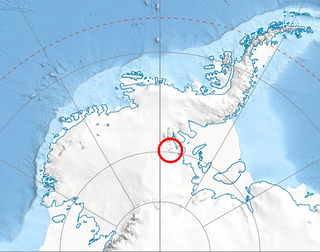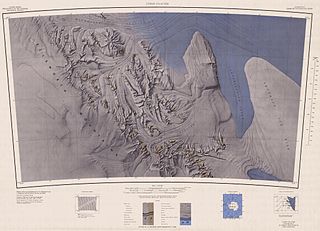Related Research Articles

The Sentinel Range is a major mountain range situated northward of Minnesota Glacier and forming the northern half of the Ellsworth Mountains in Antarctica. The range trends NNW-SSE for about 185 km (115 mi) and is 24 to 48 km wide. Many peaks rise over 4,000 m (13,100 ft) and Vinson Massif (4892 m) in the southern part of the range is the highest elevation on the continent.

The Heritage Range is a major mountain range, 160 km (99 mi) long and 48 km (30 mi) wide, situated southward of Minnesota Glacier and forming the southern half of the Ellsworth Mountains in Antarctica. The range is complex, consisting of scattered ridges and peaks of moderate height, escarpments, hills and nunataks, with the various units of relief set off by numerous intervening glaciers.
The Cook Mountains is a group of mountains bounded by the Mulock and Darwin glaciers in Antarctica. They are south of the Worcester Range and north of the Darwin Mountains and the Britannia Range.
The Bastien Range is a mountain range of moderate height which extends in a northwest–southeast direction for about 40 nautical miles, flanking the southwest side of the Nimitz Glacier and the Sentinel Range, in the Ellsworth Mountains, Antarctica.

Gifford Peaks are a line of sharp peaks and ridges along the escarpment at the west side of the Heritage Range, located between Watlack Hills and Soholt Peaks. They were named by the University of Minnesota Geological Party of 1963–64 for Chief Warrant Officer Leonard A. Gifford, a pilot of the 62nd Transportation Detachment who aided the party.
On the continent of Antarctica, the Aramis Range is the third range south in the Prince Charles Mountains, situated 11 miles southeast of the Porthos Range and extending for about 30 miles in a southwest–northeast direction. It was first visited in January 1957 by Australian National Antarctic Research Expeditions (ANARE) southern party led by W.G. Bewsher, who named it for a character in Alexandre Dumas' novel The Three Musketeers, the most popular book read on the southern journey.
The Anderson Massif is a prominent ice-covered massif about 10 nautical miles (20 km) across and rising to a height of 2,190 metres (7,190 ft), located at the junction of Splettstoesser Glacier and Minnesota Glacier in the Heritage Range of the Ellsworth Mountains, Antarctica. It was named by the Advisory Committee on Antarctic Names for John J. Anderson, a geologist who was field leader of the University of Minnesota Ellsworth Mountains Party, 1961–62.

Balish Glacier is a glacier, 18 nautical miles (33 km) long, flowing north from the Soholt Peaks to enter Splettstoesser Glacier just northeast of Springer Peak, in the Heritage Range, Ellsworth Mountains. It was mapped by the United States Geological Survey from surveys and from U.S. Navy air photos, 1961–66, and was named by the Advisory Committee on Antarctic Names for Commander Daniel Balish, Executive Officer of U.S. Navy Squadron VX-6 during Operation Deep Freeze 1965, and Commanding Officer in 1967.
Mount Besch is a mountain forming the south end of Barnes Ridge on the east side of Sentinel Range, Ellsworth Mountains. It is overlooking the terminus of Ellen Glacier to the south, Arapya Glacier to the west, and Ranuli Ice Piedmont to the northeast.
The Brown Hills are a group of mainly snow-free hills in the Cook Mountains of Antarctica.

Mount Bursik is the central peak, 2,500 metres (8,200 ft) high, of the Soholt Peaks, in the Heritage Range, Ellsworth Mountains. It was mapped by the United States Geological Survey from ground surveys and from U.S. Navy air photos, 1961–66, and named by the Advisory Committee on Antarctic Names for Captain Vlada D. Bursik, U.S. Navy, Deputy Commander, U.S. Navy Support Force, Antarctica, during Operation Deep Freeze 1966.

Owen Ridge is a very high and rugged mountain ridge, 22 nautical miles (41 km) long, which forms the southwesternmost element of the Sentinel Range, Ellsworth Mountains. It extends south-southeast from Karnare Col and includes Mount Strybing, Mount Southwick and Lishness Peak, ending up in Bowers Corner. Mapped by United States Geological Survey (USGS) from surveys and U.S. Navy aerial photography, 1957–60. Named by Advisory Committee on Antarctic Names (US-ACAN) (1974) for Thomas B. Owen, Assistant Director of National and International Programs, National Science Foundation.
Conglomerate Ridge is a ridge, 1 nautical mile (2 km) long, located 4 nautical miles (7 km) east-southeast of Mount Bursik in the Soholt Peaks, Heritage Range, Ellsworth Mountains of Antarctica. The ridge trends northwest–southeast and rises to about 1,650 metres (5,400 ft). It was so named from the conglomerate composition of the ridge by Gerald F. Webers, leader of the United States Antarctic Research Program Ellsworth Mountains Expedition, 1979–80.
Webers Peaks is a line of peaks on a ridge bounded by Splettstoesser Glacier on the north, Balish Glacier on the east and Dobbratz and Fendorf Glaciers on the west, in the Heritage Range, Ellsworth Mountains. They were named by the University of Minnesota Ellsworth Mountains Party of 1962–63 for geologist Gerald F. Webers, a member of that party.

Drake Icefall is an icefall 2 nautical miles (4 km) wide between the Soholt Peaks and the Edson Hills in Antarctica, draining eastward from the plateau to join the general flow of Union Glacier through the Heritage Range, Ellsworth Mountains. It was named by the University of Minnesota Ellsworth Mountains Party, 1962–63, for Benjamin Drake IV, a geologist and member of the party.
Eley Peak is a small rock peak (2311m) in the northern part of the Soholt Peaks, overlooking the head of Balish Glacier in the Heritage Range of the Ellsworth Mountains. It was mapped by the United States Geological Survey from surveys and U.S. Navy air photos, 1961–66, and was named by the Advisory Committee on Antarctic Names for Richard G. Eley, a U.S. Navy photographer on flights over Marie Byrd Land and Ellsworth Land, 1965–66 and 1966–67. It was first climbed on December 20, 2013, by Ralf Laier, Pachi Ibarra and Seth Timpano in Alpine style during their traverse of the Soholt Peaks.
Gambacorta Peak is a peak 1,840 metres (6,040 ft) high, standing 4 nautical miles east of Mount Kaschak in the southern Neptune Range, Pensacola Mountains, Antarctica.
Mount Macalester is a prominent peak rising to 2,480 metres (8,140 ft) in the central part of the Soholt Peaks, Heritage Range, Ellsworth Mountains, Antarctica. It was mapped by the United States Geological Survey from surveys and U.S. Navy aerial photographs from 1961 to 1966. The peak was named by the Advisory Committee on Antarctic Names after Macalester College, the alma mater of Gerald F. Webers, the leader of the United States Antarctic Research Program Ellsworth Mountains Expedition of 1979–80. It was first climbed on December 28, 2013, by Ralf Laier, Pachi Ibarra and Seth Timpano in Alpine style during their traverse of the Soholt Peaks.
The Lillie Range in Antarctica extends northward from the Prince Olav Mountains to the Ross Ice Shelf. Mounts Hall, Daniel, Krebs and Mason are in the range.
The Thomas Hills are a linear group of hills, 17 nautical miles long, between Foundation Ice Stream and MacNamara Glacier at the north end of the Patuxent Range in the Pensacola Mountains, Antarctica.
References
![]() This article incorporates public domain material from "Soholt Peaks". Geographic Names Information System . United States Geological Survey.
This article incorporates public domain material from "Soholt Peaks". Geographic Names Information System . United States Geological Survey.